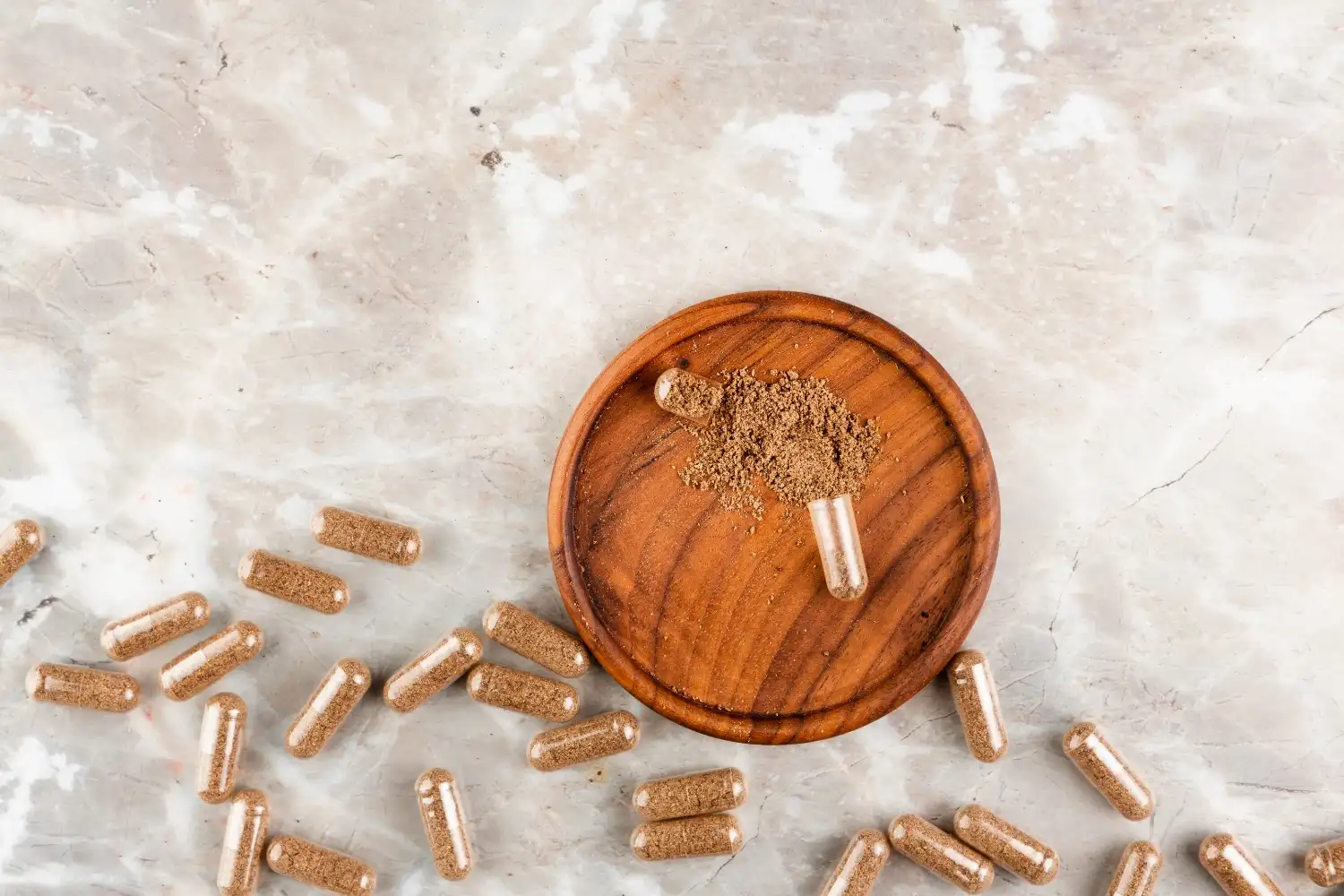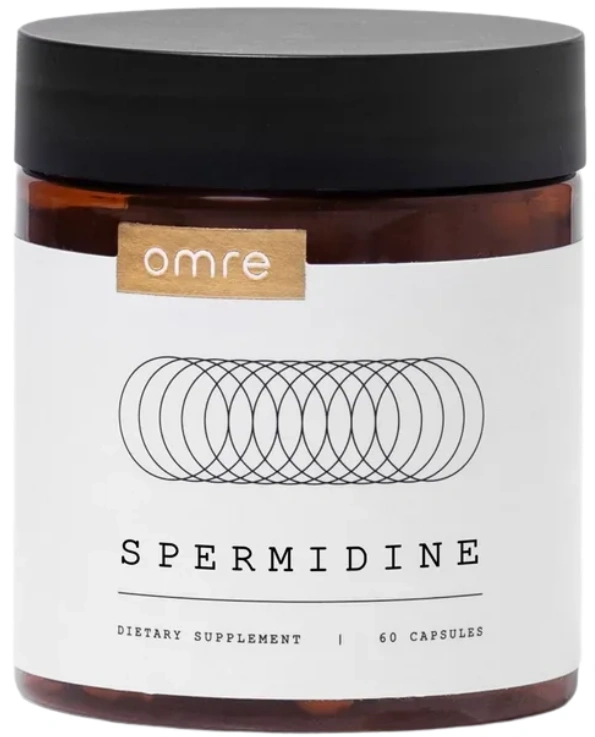Table of Contents
- What Exactly Is Spermidine?
- How Spermidine Work in the Body
- What Is Spermidine Good For? (Research-Based Benefits)
- Spermidine Supplement Benefits
- Natural Food Sources of Spermidine
- How to Support Natural Spermidine Levels
- Are There Any Side Effects of Spermidine?
- How Much Spermidine Do You Need?
- Should You Try a Spermidine Supplement?
- Final Words
- FAQs on Spermidine
- What is Spermidine good for overall?
There are feelings that accompany aging. One of such is that your body finds it really hard to bounce back quite like it used to.
These feelings are mostly apparent in people between the ages of 35 and 60. And if you are within this range, you have probably noticed recovery takes longer, your focus fades faster, or your skin feels a little less vibrant than it once did.
What happened is that those are not just signs of time passing you by but signs that your cells are signaling for renewal due to the passage of time.
In the past, it was hard, but now researchers have discovered a natural way to help those cells refresh themselves again. And the name of that compound is Spermidine, one of the most studied and promising molecules in the science of healthy aging.
Spermidine isn’t a synthetic creation. It’s a compound your body already makes—and one you can get from everyday foods like soybeans, mushrooms, and wheat germ. Its power lies in something called autophagy, your body’s built-in process for cleaning out damaged cells and recycling them for energy and repair.
When you’re young, autophagy runs smoothly. But as you age, it slows down and that’s when fatigue, slower recovery, and visible aging begin to show up. Spermidine helps reignite that renewal process, helping your body clear out the old and make room for the new.
That’s why research links it to better heart health, brain function, and even longer lifespan, benefits that make it one of the most talked-about discoveries in modern longevity science.
As you continue reading, kindly note that this content is for educational purposes only and not medical advice. Always speak with a healthcare professional before starting any supplement.
On here, you’ll learn all about Spermidine.
Key Summary
-
Spermidine supports healthy aging by reactivating cellular cleanup and renewal through autophagy.
-
Research connects Spermidine to longevity, improved heart and brain health, and stronger metabolism.
-
Natural sources include wheat germ, soy, mushrooms, and aged cheese.
- Supplements offer a concentrated, bioavailable way to maintain Spermidine levels as they naturally decline with age.
SPERMIDINE
Cellular autophagy activator, providing a potent and highly purified dose of Spermidine.*
What Exactly Is Spermidine?
butane-14-diamine_200_2.svg-(1)-v1762072330778.webp) Spermidine is a naturally occurring molecule called a polyamine that supports cell growth, repair, and healthy aging. It’s found in every living cell and in foods such as soybeans, whole grains, and aged cheese.
Spermidine is a naturally occurring molecule called a polyamine that supports cell growth, repair, and healthy aging. It’s found in every living cell and in foods such as soybeans, whole grains, and aged cheese.
In simple terms, spermidine helps your body maintain and renew its cells.
As we age, our natural levels of this compound decline, which may slow down cellular repair and contribute to aging.
Getting enough spermidine, through diet or supplements, may help counter that decline.
Some quick facts about spermidine:
It was first discovered in 1678 by Antonie van Leeuwenhoek.
The name comes from its initial discovery in semen, where levels are naturally high.
Your gut bacteria also produce spermidine, linking it closely to gut health.
It helps stabilize DNA, RNA, and proteins that keep cells functioning properly.
In short, spermidine is like an internal maintenance worker. It helps your body clear out damaged parts, rebuild what’s needed, and keep your cells performing at their best.
When Spermidine levels are steady, your cells renew and function optimally. When they drop, that renewal slows and the aging process speeds up.
That’s why researchers call it one of the “master molecules of longevity.”
How Spermidine Work in the Body
Spermidine supports longevity by triggering autophagy—your body’s natural system for recycling old or damaged cell components—and by protecting cells from oxidative stress and inflammation.
Together, these effects create a ripple of benefits for energy, focus, metabolism, and overall vitality. Here’s how spermidine does its job inside your body:
1. Stimulates Autophagy
Autophagy is your body’s deep-cleaning mechanism — it breaks down old, damaged cell parts and recycles them for energy.
But as you age, this process slows down, allowing cellular waste to accumulate.
Spermidine helps reverse that decline. Studies show it can activate the genes responsible for autophagy (1), keeping your cells young, efficient, and functional longer.
This renewal process has been linked to longer lifespan, better heart performance, and improved brain function.
2. Protects Cells from Oxidative Stress
Every day, your cells battle oxidative stress, damage caused by unstable molecules known as free radicals.
Left unchecked, this stress leads to DNA damage, inflammation, and accelerated aging.
Spermidine enhances your body’s natural antioxidant defenses, helping to:
Reduce oxidative damage in heart and brain tissue.
Support maintain mitochondrial health, your body’s energy engines.
Keep DNA strands stable and resilient.
Simply put, Spermidine helps shield your cells from the invisible stress that makes you feel older than you are.
3. Balances Inflammation and Immunity
A little inflammation is healing; too much is harmful. Spermidine helps your body find that balance, calming overactive inflammation while keeping your immune defenses strong.
Studies show that it:
Reduces pro-inflammatory cytokines (molecules that trigger chronic inflammation).
Improves immune response, especially in older adults.
Supports gut bacteria that regulate immune function.
This cellular harmony is one reason researchers link Spermidine to healthier aging and stronger longevity outcomes.
Reset Your Cellular Clock
You can’t pause time, but you can help your cells act younger.
OMRE Spermidine is formulated to do exactly that. It combines purity, potency, and proven bioavailability to restore your body’s natural renewal systems.
Support your cells today. Strengthen your tomorrow.
Shop OMRE Spermidine →
What Is Spermidine Good For? (Research-Based Benefits)
 Spermidine’s benefits stretch across nearly every major system in the body — from heart and brain function to metabolism and cellular repair. Most of the data comes from lab and animal studies, but early human research shows the same promising direction: keeping cells young keeps you well.
Spermidine’s benefits stretch across nearly every major system in the body — from heart and brain function to metabolism and cellular repair. Most of the data comes from lab and animal studies, but early human research shows the same promising direction: keeping cells young keeps you well.
1. Cellular Rejuvenation and Anti-Aging
One of the most promising spermidine benefits involves cellular rejuvenation. Spermidine helps trigger autophagy, the body’s process of recycling worn-out or damaged cell components. This cleanup supports healthier, longer-living cells (2).
In studies, spermidine has been shown to:
Support DNA repair and protein balance inside cells.
Reduce the buildup of cellular waste that contributes to aging.
Help maintain energy production and cellular efficiency.
By keeping this renewal cycle active, spermidine may help preserve the body’s ability to repair itself and maintain youthful function over time.
2. Longevity Support
Spermidine is often linked with healthy lifespan extension, mainly based on animal research. In studies with yeast, flies, and mice, spermidine supplementation appeared to lengthen lifespan and improve cellular resilience (3).
Observational studies in humans have also noted that people who consume spermidine-rich diets tend to have lower mortality rates, especially from heart disease and certain cancers.
While these findings don’t prove cause and effect, they hint at a strong connection between spermidine intake and long-term health.
Researchers believe spermidine works by activating similar biological pathways to those triggered by calorie restriction, one of the most studied longevity strategies.
3. Cardiovascular Health
Spermidine’s potential to support heart health has gained attention in recent years. In animal studies, regular intake appeared to:
Improve heart muscle flexibility and performance.
Support healthy blood pressure by relaxing blood vessel walls.
Reduce inflammation and oxidative stress in heart tissue.
Long-term research in mice also showed that those given spermidine lived longer and maintained stronger cardiac function (4). Human studies echo this trend, linking higher dietary spermidine to better cardiovascular outcomes.
These effects are believed to stem from spermidine’s influence on autophagy and its gentle anti-inflammatory properties, both of which help the cardiovascular system function more smoothly with age.
4. Neuroprotection and Cognitive Health
Spermidine is being studied for its role in brain protection and cognitive function. In aging models, spermidine supplementation has been observed to support memory and protect neurons from damage.
It appears to work by promoting autophagy in brain cells, which helps clear toxic proteins linked to cognitive decline. Spermidine also supports mitochondrial energy production, which keeps brain cells active and healthy (5).
In one human trial involving older adults, spermidine supplementation showed no significant improvement in memory compared to placebo, though researchers noted the dose used might have been too low to see full effects (6).
Overall, findings suggest spermidine may help maintain brain health as part of a long-term lifestyle approach.
5. Immune System Modulation
Spermidine plays a role in balancing the immune system. Research indicates it may encourage the formation of new immune cells while calming excessive inflammation that can damage tissues (7).
Studies suggest spermidine:
Helps renew immune cells in aging bodies.
Supports healthy gut bacteria that influence immune defense.
May reduce inflammatory molecules associated with chronic disease.
This balancing effect helps the body respond to infections more effectively without triggering unnecessary inflammation, a key factor in healthy aging.
6. Potential Cancer Prevention
Early evidence hints that spermidine could support the body’s natural defenses against certain cancers. In lab studies, it has been shown to help regulate cell growth and promote autophagy, which removes damaged or precancerous cells before they multiply (8).
Researchers have observed particularly strong effects in liver and colon tissues, where spermidine appears to slow abnormal cell activity and reduce tumor formation in animal models (9).
While this area of research is still in its early stages, spermidine’s role in maintaining normal cell turnover makes it a compelling topic for future cancer prevention studies.
7. Lipid Metabolism and Weight Regulation
Spermidine also seems to influence how the body handles fats and energy. Research in animals suggests it may improve lipid metabolism and insulin sensitivity, both of which are vital for metabolic balance (10).
Findings include:
Better fat breakdown in high-fat diet conditions.
Improved blood sugar control through enhanced insulin response.
Increased thermogenesis, or natural fat burning, at the cellular level.
These results point toward a possible role for spermidine in supporting healthy weight management and metabolic function, though human data remains limited.
Experience the Proven Benefits of Spermidine
Decades of research show what Spermidine can do for your cells: protect, renew, and extend vitality.
Now it’s your turn to put that science to work.
OMRE Spermidine delivers a clinically aligned dose that supports autophagy, energy, and longevity, no complex routine is required.
Reclaim the energy of your prime naturally.
Shop OMRE Spermidine →
Spermidine Supplement Benefits
By now, the science is clear: Spermidine helps your body renew itself from within. But what’s even more exciting is that you don’t need to rely solely on diet to get it.
Spermidine supplements offer a concentrated, research-backed way to support cellular repair, heart and brain function, and healthy aging, all by activating autophagy, your body’s natural cleanup and renewal process.
Most high-quality Spermidine supplements are made from purified wheat germ extract, providing a potent dose of this longevity compound in a form your body can absorb easily.
And here’s the key: all the science-backed benefits discussed above—improved cellular repair, better heart health, sharper brain function—also apply to Spermidine in supplement form. They’re designed to help maintain optimal levels even as your body’s own production declines with age.
Here’s what Spermidine supplements may help you achieve:
Support cellular repair and renewal through autophagy.
Promote healthy heart function and balanced blood pressure.
Protect brain cells from oxidative stress and age-related decline.
Encourage a balanced immune response and reduce chronic inflammation.
Help maintain skin, hair, and tissue health.
Support metabolic balance and healthy fat regulation.
Experience Science-Backed Renewal in a Capsule
You’ve seen what the studies reveal: Spermidine supports the same cellular processes linked to youth, energy, and longevity. Now, you can experience those results for yourself.
OMRE Spermidine delivers a pure, clinical-grade dose designed to trigger autophagy and support healthy aging from the inside out.
Each capsule is third-party tested for potency and purity, so the research you’ve read about translates into real, daily benefits.
Shop OMRE Spermidine — Backed by Science, Made for Everyday Renewal
Natural Food Sources of Spermidine
You can also boost your Spermidine intake naturally through everyday foods. Many plant-based and fermented options are rich in this compound and easy to add to your meals.
How to Support Natural Spermidine Levels
-v1762072753851.webp) Your body produces some Spermidine naturally, but diet, lifestyle, and gut health all play key roles in maintaining those levels.
Your body produces some Spermidine naturally, but diet, lifestyle, and gut health all play key roles in maintaining those levels.
Here’s how to keep your natural Spermidine production strong:
Eat a Spermidine-rich diet: Include wheat germ, soy, mushrooms, and whole grains regularly.
Support gut health: Your gut bacteria produce spermidine—feed them with fiber-rich foods and fermented options like kimchi or yogurt.
Stay active: Regular exercise promotes autophagy, similar to Spermidine’s renewal effects.
Get quality sleep: Rest allows your body to repair and rebuild efficiently.
Try intermittent fasting: Fasting enhances Spermidine activity and autophagy.
- Reduce chronic stress: Long-term stress depletes antioxidants and slows cellular recovery.
SPERMIDINE
Cellular autophagy activator, providing a potent and highly purified dose of Spermidine.*
Are There Any Side Effects of Spermidine?
When it comes to Spermidine, the science—and safety record—is reassuring.
Research shows that Spermidine is generally well-tolerated, especially when derived from food-based sources like wheat germ extract.
In a 2022 clinical study, older adults took 750 mg of wheat germ extract daily for 12 months (containing about 6 mg of Spermidine) and experienced no serious side effects. Researchers noted that while higher doses might yield stronger results, even moderate use proved safe (11).
That said, everyone’s body is different. When introducing any supplement, mild and temporary reactions can occur, particularly at higher doses or with sensitive digestion. These may include:
Mild stomach discomfort or bloating
Nausea (especially if taken on an empty stomach)
Loose stool or digestive changes
Occasional headaches in sensitive individuals
Most people find these effects fade quickly once the body adjusts, especially when Spermidine is taken with food and in divided doses.
If you experience persistent discomfort, pause use and consult your healthcare provider before continuing.
Spermidine’s benefits are powerful but only when delivered safely and cleanly.
That’s why OMRE Spermidine uses a highly purified, third-party tested formula derived from natural wheat germ extract, the same source used in clinical studies.
It’s science you can trust, built for real-world results and everyday use.
Try OMRE Spermidine, it’s Clinically Formulated for Safe, Effective Cellular Renewal
How Much Spermidine Do You Need?
A typical spermidine dosage ranges from 5 to 10 mg per day, depending on your health goals and the supplement form. Studies show that doses up to 6 mg daily are well tolerated, and many products now offer around 10 mg per serving (12).
This level is commonly used in research on healthy aging and autophagy. Some people may choose higher amounts, around 10 to 20 mg daily, especially if their diet is low in spermidine-rich foods.
Short-term use of higher doses up to 20 mg has also been shown to be safe in healthy adults (11). As with any supplement, start low and check with your healthcare provider to find the right amount for your needs.
Still, the smartest approach is simple:
Start low (5–6 mg daily) to let your body adapt.
Stay consistent for at least 6–12 weeks results build over time.
Work with your healthcare provider to tailor your routine if you’re managing specific conditions.
Remember, Spermidine’s power comes from consistency, not excess. Even smaller daily doses can make a meaningful difference in your body’s renewal process.
You don’t need high doses to see results, you just need the right one.
OMRE Spermidine provides a clinical-strength dose aligned with modern research, giving your cells the support they need to repair, renew, and perform better every day.
Shop OMRE Spermidine. Get Pure, Research-Backed Cellular Support
Should You Try a Spermidine Supplement?
Spermidine supplements may be worth trying if you want to support healthy aging and cellular repair, especially if your diet lacks spermidine-rich foods. They’re considered safe for most adults when taken as directed, though results may vary.
For people who don’t get enough spermidine from diet or want a more targeted dose, supplements offer a convenient option. They’re typically derived from natural wheat germ extract and standardized for purity and concentration.}
Still, spermidine supplements aren’t a quick fix. Their benefits are best realized when paired with healthy habits like balanced nutrition, exercise, and good sleep.
While early research is encouraging, more human trials are needed to confirm the full scope of long-term benefits.
If you’re considering spermidine supplements, start gradually and consult your healthcare provider, especially if you take medication or have health conditions.
At Omre, we believe in helping you live healthier for longer through science-backed nutrition.
Our supplements are formulated with high-quality, research-based ingredients like spermidine, NMN, and resveratrol, crafted to support your body’s natural vitality and longevity.
Explore our range and take your next step toward aging well, naturally.
Turn Cellular Science Into Daily Strength
At OMRE, we believe that longevity revolves around sustaining vitality.
That’s why our OMRE Spermidine formula combines purity, precision, and proven results, helping your body renew itself from within, one capsule at a time.
Explore OMRE Spermidine, Science-Backed Support for Healthy Aging
Final Words
When it comes to longevity science, few discoveries are as compelling as Spermidine.
It’s not a fad or a synthetic creation, it’s a naturally occurring compound your body already produces to help you renew, repair, and restore from the inside out.
By supporting autophagy, Spermidine helps clear damaged cells, reduce oxidative stress, and keep your body’s repair systems running smoothly.
The result? More energy, sharper focus, and stronger resilience, the very qualities that begin to fade as we age.
While most of today’s research comes from animal and early human studies, the data continues to build one clear picture: consistent Spermidine intake supports healthy aging at a cellular level.
Adding Spermidine-rich foods like wheat germ, soy, or mushrooms is a great start.
But if you’re looking for a more targeted, research-backed approach, OMRE Spermidine offers a simple, effective solution.
Each capsule provides a highly purified, clinically aligned dose, helping your cells recycle, repair, and perform at their best every day.
Shop OMRE Spermidine: Backed by Science, Trusted for Longevity.
FAQs on Spermidine
Is Spermidine a vitamin or amino acid?
Neither. Spermidine is a polyamine, a natural compound that helps your cells grow, repair, and stay balanced. Think of it as one of your body’s quiet protectors, working behind the scenes to keep you healthy.
Can Spermidine make you live longer?
Animal research suggests that Spermidine may extend lifespan by activating autophagy — the body’s self-cleaning and repair system.
While human studies are still early, researchers see it as a key piece of the longevity puzzle rather than a “magic pill.”
What foods have the most Spermidine?
Wheat germ, soybeans, mushrooms, aged cheeses, and whole grains are some of the richest natural sources. Eating a varied diet that includes these foods helps keep your Spermidine levels stable and supports your body’s renewal processes.
Is Spermidine safe to take daily?
Yes, studies show that Spermidine is well-tolerated when taken in moderate amounts, especially when derived from food-based sources like wheat germ extract.
Always consult your healthcare provider before starting a new supplement, particularly if you take medications or have health concerns.
What is Spermidine good for overall?
Spermidine supports healthy aging by promoting autophagy, balancing inflammation, and protecting your heart, brain, and cells from oxidative stress.
In short, it helps your body age better, feel better, and perform better.
The Science You Can Feel
Science may explain how Spermidine works, but OMRE Spermidine helps you feel it, through better energy, sharper clarity, and renewed vitality, day after day.
It’s not about turning back time. It’s about giving your body the tools to thrive as the years move forward.
Try OMRE Spermidine, Cellular Renewal Backed by Science





